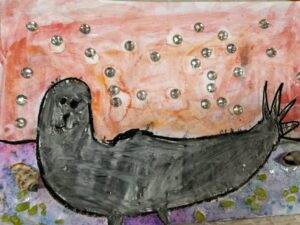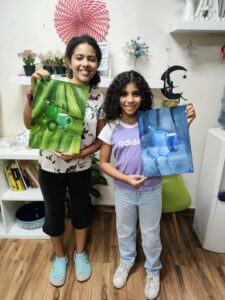Is this a normal drawing for a child of my son’s age? I don’t understand their scribbles, shouldn’t they be drawing clear pictures by now? My child loves art, but when I sent her to class, she got bored after a few sessions, what am I doing wrong?
You’re not doing anything wrong and chances are, you’re child’s art skills are normal for their age. As parents and teachers, we all want to see our kids succeed. We want to help them become independent artists and individuals. To reach that point though, we need to understand where they are in their art journey and how their art skills develop. Children of different ages will have different abilities and skills. And it doesn’t matter how advanced a child may be. we have to respect their developmental milestones and work with them.
No child enjoys doing art projects meant for adult learners. Still life and pencil drawings are not projects most children enjoy. Kids prefer colours and paint and mess, especially at younger ages like 4 or 5. Our goal is to create fun, engaging, and effective lessons that will inspire your child and help them develop their skills! We’d love to give your toddler a head start on their art journey and have some great tips for you to try out. And if you’re interested in what we have planned for older children, keep reading for more information. Thanks for joining us on this adventure!
Art skills for ages 15 months – 3 Years old
Fine Motor capabilities
- Children can hold and grasp tools but movements are not controlled yet
- Children still love to explore with their mouth so make sure all the materials they get are large and non toxic
Child concentration time
- At a young age children’s concentration time usually starts at a few minutes. As they get older, it can expand up to 15, or 20 minutes.
- This is the time to introduce them to materials and allow them to explore
- Start off the art making time with a few minutes and with time add on up to 15 minutes as they get older (2-3 years).
Ability to follow directions
- Children still can’t follow directions so the art making process can’t be step by step instructions. Art should be an exploratory process
What can they learn in art?
- They enjoy playing with crayons and coloured pencils.
- They love to mimic adults that are making marks. This can be a fun bonding activity to do with them
- They love to paint, they can learn to dip the brush in paint and make brush strokes
- They also love to use their fingers and tools like rollers.
- Don’t do any directed lessons, allow them to explore and attempt to use the tools for mark making
- They can start to recognize colours and will play with colours in a very exploratory way.
- They can model with clay and play with playdough and types of clay.
- They can’t use scissors and glue yet, so crafting is still not very possible at this age
How can I support their love for art?
- Don’t correct them or give them directions to do it right. Instead, you can provide them with a space to learn and explore.
- Give them a piece of white paper and a black crayon as a start. Toddlers love the contrast between the white paper and the black crayon.
- Give them things like paint sticks, if you’re trying to avoid the mess, or coloured chalk. Big brushes, sponges and paint are also some wonderful materials to explore.
- You want to avoid pencils, small items and modeling clay at this stage.
- Focus on exploratory projects instead of product oriented projects. They can’t follow directions and finish a project yet. Art should be more like a science experiment.
- Give them premixed paint colours and one brush per container – large brushes
- Children get messy and it’s very hard to stay clean so embrace the mess and have fun. That is how they will learn.
Art skills for ages 3-6
Fine motor capabilities
- Between ages 3 and 4 children can follow fine motor movements with simple directions.
- Sometimes it is necessary for them to use a tracer or template to trace an outline. They will not rely on it forever, but it will help their motor control
- They can start to learn cutting around age 5, and by age 6 they can cut diagonal lines to make shapes like triangles.
Child concentration time
- Between ages 3 and 4 children can work up to 30/40 minutes at a time at home.
- Children can follow a simple guided lesson but still need to work in a discovery, exploratory way.
- Children ages 5 and 6 can work up to one hour on a single project.
Ability to follow instructions
- Children at these ages (3-4) can follow simple, guided instructions but will still need help.
- Children ages 5-6 years old can listen to instructions, and work by following them.
What can they learn
- Children ages 3-4 can start to make controlled brush strokes
- They can paint the surface of an object, and can learn to make basic brush strokes
- Children between the ages of 5 and 6 can make lines, dots, dashes, wavy lines,
- Children ages 3 and 6 can identify colours and learn basic colour mixing.
- Children between ages 3 and 4 love to work with modeling clay.
- Some children will have a better grasp than others. So it’s important to take the time to work with each child from whichever level they’re at.
- Children enjoy following instructions with clay between the ages of 5 and 6. Younger kids enjoy more free play and getting creative
- Children 3 to 4 can learn to cut with scissors and use glue and fold paper for very simple projects.
- Older kids, ages 5 can also do more complex projects with paper, cutting and gluing.
- You should never start teaching technical ideas like shading to children this age. At this age, their visual perception is still developing. And even if they seem to apply the concept, they will not understand it.
- Children as young as five can start to learn what a horizon line is and can paint above/below the horizon line

How can I support their love for art?
- Colours at this stage don’t represent reality, not always. They also don’t have any psychological meaning behind them. For that reason, I would advise you to not correct them on their use of colours. They’re enjoying colour for its own sake. If they love pink, it will show up often. If rainbows are their favourite, they will paint them in everything.
- Ask simple questions like tell me about your drawing. Why did you use this colour? Who is this? What is your favourite part in the painting? Why? This is a fun way to bond with your child and allow them to exercise their critical thinking skills.
- Be gentle with them and avoid asking questions like what is this. It could make the child feel like they failed to represent their idea.
- Be sure to display the projects so that children can reflect on the process and outcome
Art skills for ages 6-12
Fine Motor capabilities
- Ages 6-8 children have good fine motor skills and are able to use most art materials.
- Children at these ages are not always skilled at most art tasks. You should give them lots of opportunities to try lots of different art mediums out

Child concentration time
- Children between ages of 6 and 8 can work up to an hour or an hour and half. As they get older, they can work for longer, so up to two hours.
- They can concentrate more, can work on their own and use their imaginations.
Ability to follow directions
- Between ages 6-8, children like to follow step by step instructions.
- Children older than 8 can start to draw from observation.
What they can learn
- Children age 8 can learn basic shading and texture techniques.
- Children ages 8 and older can exercise observation skills by looking at objects to draw them.
- As children get older (9+), they can learn more techniques on how to make things more realistic.
- From age 9, children can also start learning the basic composition ideas.
- Children from age 8 will start to add details to their artworks. They can learn more complex concepts like one point and atmospheric perspective.
- Between ages 10-12 children can learn about the elements of design.
- They can learn modeling, sculpting and basic ceramic techniques

How can I support their love for art?
- Children are already critical of themselves at this stage so avoid adult criticism.
- Don’t overwhelm younger children with colour choices.
- Ages 8-11 are the best ages to visit a museum with children and have a discussion of the artworks you’re viewing
- Start a discussion about the materials and techniques used in the artwork.
I firmly believe that every child has a unique and beautiful talent waiting to be discovered through art. Understanding where they are in their journey can open up doors to new creative possibilities and a world of joy and fulfillment.
Are you ready to start them on a fun art journey? Join our studio or at-home art programs to promote growth and skill development for your child. Sign up now to spark their passion for art and unleash their creativity! Contact us today for more information.
Happy Painting
Explore. Evolve.



